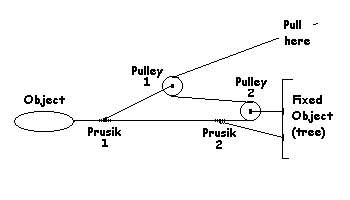Z-drag on:
[Wikipedia]
[Google]
[Amazon]
 A Z-Drag or Z-Rig is an arrangement of lines and pulleys, effectively forming a
A Z-Drag or Z-Rig is an arrangement of lines and pulleys, effectively forming a
 A Z-Drag or Z-Rig is an arrangement of lines and pulleys, effectively forming a
A Z-Drag or Z-Rig is an arrangement of lines and pulleys, effectively forming a block and tackle
A block and tackle or only tackle is a system of two or more pulleys with a rope or cable threaded between them, usually used to lift heavy loads.
The pulleys are assembled to form blocks and then blocks are paired so that one is fixed and on ...
, that is commonly used in rescue situations. The basic arrangement results in pulling the hauling end 3 times the distance the load is moved, providing a theoretical mechanical advantage of ''three to one''. In actual practice the advantage will be reduced by friction in the pulleys or carabiners. The advantage will also be reduced if the pull on the hauling end is not parallel to the direction the load moves in. The name comes from the fact that the arrangement of lines is roughly Z shaped. Besides the mechanical advantage to pulling, it also uses only part of the total length of the rope for the block and tackle
A block and tackle or only tackle is a system of two or more pulleys with a rope or cable threaded between them, usually used to lift heavy loads.
The pulleys are assembled to form blocks and then blocks are paired so that one is fixed and on ...
arrangement.
The typical configuration (see diagram) uses two single pulley
A pulley is a wheel on an axle or shaft that is designed to support movement and change of direction of a taut cable or belt, or transfer of power between the shaft and cable or belt. In the case of a pulley supported by a frame or shell that ...
s and two Prusik knot
A Prusik ( ) is a friction hitch or knot used to attach a loop of cord around a rope, applied in climbing, canyoneering, mountaineering, caving, rope rescue, ziplining, and by arborists. The term Prusik is a name for both the loops of cord used ...
loops or other suitable friction hitch
A friction hitch is a kind of knot used to attach one rope to another in a way that is easily adjusted. These knots are commonly used in climbing as part of single-rope technique, doubled-rope technique and as "ratchets" to capture progress on a ...
es. These Prusiks provide fixed attachment points on the rope that can be moved when slightly loosened. The first Prusik knot is attached to the "traveling pulley," allowing it to pull on the load. The second Prusik knot is used to hold the position of the rope and is referred to as a 'progress capture device' or ratchet. Because the tension on the line stores energy and could present a dangerous flying hazard if the rope were to break it is also advisable to attach a towel or soft object (such as a life vest) to the end of the line near the connection to the object being pulled, to act as padding, and/or a damping device.
Borrowed from rock climbing
Rock climbing is a sport in which participants climb up, across, or down natural rock formations. The goal is to reach the summit of a formation or the endpoint of a usually pre-defined route without falling. Rock climbing is a physically and ...
, the Z-Drag is considered an important tool in whitewater
Whitewater forms in a rapid context, in particular, when a river's gradient changes enough to generate so much turbulence that air is trapped within the water. This forms an unstable current that froths, making the water appear opaque and ...
rescue and is used primarily for the recovery of pinned boats. It is also considered a useful tool in many types of rope rescue
Rope rescue is a subset of technical rescue that involves the use of rope, be it steel or cable rope, or more commonly used nylon, polyester, or other type of rope. Kernmantle (kern = core and mantle = sheath) rope as it is called, is available ...
because of its simplicity, and is commonly used for lifting systems that don't require more mechanical advantage.
It also serves as an excellent method for tightening the rope to be crossed in a Tyrolean traverse
A Tyrolean traverse is a method of crossing through free space between two high points on a rope without a hanging cart or cart equivalent. This is used in a range of mountaineering activities: rock climbing, technical tree climbing, caving, w ...
, where the other end is also fixed to a stable object.
See also
*Trucker's hitch
The trucker's hitch is a compound knot commonly used for securing loads on trucks or trailers. This general arrangement, using loops and turns in the rope itself to form a crude block and tackle, has long been used to tension lines and is kn ...
- another 3-fold advantage system using single loops
*Mechanical advantage
Mechanical advantage is a measure of the force amplification achieved by using a tool, mechanical device or machine system. The device trades off input forces against movement to obtain a desired amplification in the output force. The model for t ...
References
General references
* Swiftwater Rescue: A Manual for the Rescue Professional * Whitewater Rescue Manual: New Techniques for Canoeists, Kayakers, and Rafters * River Rescue: A Manual for Whitewater Safety * Swiftwater Rescue Safety equipment Ropework Swiftwater rescue {{tool-stub